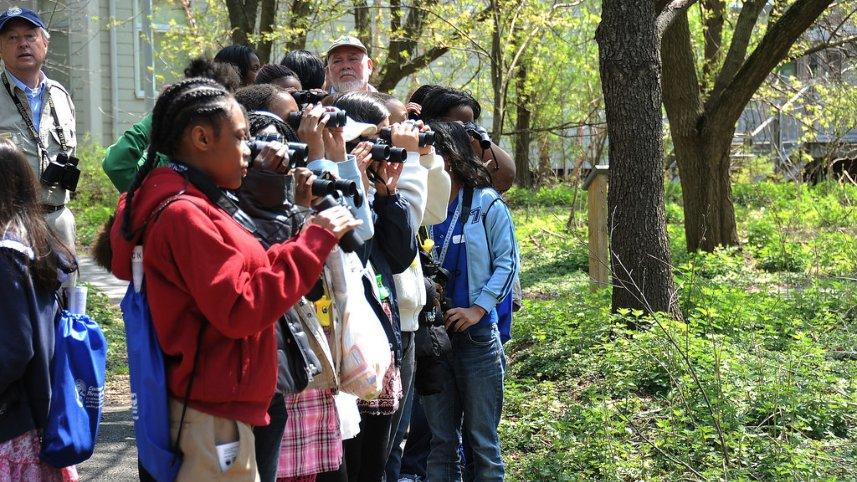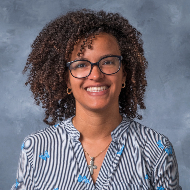Diversity issues within inquiry-based citizen science

In the Rio Grande Valley of Texas, Global Big Day 2019 was taken seriously. Global Big Day is an annual event where birders are encouraged to record as many bird sightings as possible in 24 hours on a phone app called eBird. The worldwide events include professional falconers, famous bird-watchers, art vendors, and ornithologists that have spent their lives studying and recording birds. Over 35,000 participants attend Global Big Day in several different places around the world, recording close to 7,000 bird species.
In another part of the Rio Grande Valley, there is a city park, Quinta Mazatlan, with a natural Tamaulipan thorn forest and an adobe mansion. Around the same time as Global Big Day 2019, about 20 students from a local high school visit Quinta Mazatlan. The students learn what type of common plants there are in the area, set up a 30-meter transect, and record all the plants they can identify on a phone app called iNaturalist. The birders during Global Big Day and the students at Quinta Mazatlan voluntarily performed two different types of citizen science. Yet despite the distinct differences between the two, they held one thing in common: certain demographic groups were not represented.
What is citizen science?
Citizen science is research conducted by people who typically do not hold the title “scientist” as a paid position. The type of research conducted lends itself to community involvement. Some examples include surveying wildlife, identifying local trees, or even tracking animal populations as part of fishing and hunting. Because citizen scientists often rely on their mobile devices and associated apps, as technology advances and becomes more accessible, so does the practice of citizen science. Many citizen science projects create greater understanding of natural and urban communities. They may involve monitoring the ecology of a swamp, determining the number of stars seen in the night sky, or recording bird deaths caused by window collisions.The work of citizen scientists can sometimes result in the publication of scientific articles—many articles using eBird data have been published, for example.
Beyond its utility, citizen science can also be enjoyable. A family might visit a nearby natural butterfly sanctuary and have a great day. If the family photographs those butterflies and shares the photos with their local environmental agency or posts them on a citizen science app, they have also done their community a service.
Which demographic groups are underrepresented and which are overrepresented?
Unfortunately, not all demographic groups are represented equally in citizen science. Those who participate in citizen science activities most often are people of European descent and individuals with a college degree. Other groups may experience access issues. For example, people who participate in Global Big Day can take off from work for half a day (or more). The two citizen science events, Global Big Day and the Quinta Mazatlan experience, were available to two specific audiences—by extension excluding others. And those not represented in citizen science are also underrepresented in formal science.
Why are these demographic groups not represented in citizen science?
There are a number of possible reasons why people who are not of European descent or hold a college degree are not active in a scientific community:
- Many people of underrepresented groups may not participate in citizen science because they are underrepresented in science generally. A great example of this lack of representation in science generally is the current number of evolutionary biology professors in the U.S. who identify as African American. These professional scientists make up less than 3% of the field while African Americans make up approximately 12% of the population in the U.S.
- Certain groups may also be underrepresented in science because of cultural disdain for how science progresses in Western culture. Some Native Americans, for example, may view Western science as reductionist, or linear, when compared to their own science. They could view Western science as bogged down by a constant struggle with Western religion whereas traditional Native American wisdom is not exclusive from its religion. Native Americans may also view some science being explored by Westerners as already understood tribal knowledge.
- Adults without college degrees may not be aware of citizen science opportunities. This could be because the people leading citizen science opportunities may not advertise broadly enough. For example, many scientific articles are produced by scientists in academic institutions. These scientists spread the news of citizen science opportunities first to those with college degrees, or those working on college degrees, due to proximity.
How can more people be enticed to participate in citizen science?
Fortunately, certain types of citizen science have become more accessible and more popular. Birding is now a very popular pastime in the US—more so than fishing and hunting. Some birders can step outside their homes and document which types of birds they see visiting their backyard feeders. Some birders (many of them retirees) travel miles to the Lower Rio Grande Valley during the winter months to catch a glimpse of a migrating bird from Mexico. Luckily for birders (about 500,000 people globally), the eBird app mentioned earlier can be used to record the birds seen. eBird lists common birds in your area and suggests nearby hotspots for birding. It’s an easy-to-use, free app making it quite accessible; so many birders are using it that some researchers have started using the data from the app to inform habitat management. There are other similar citizen-science-based apps that are also very user friendly: iNaturalist, Loss of the Night, and Pl@ntnet, to name a few. These apps, and the fact that most people carry mobile phones that are app-based, may represent a way to encourage greater participation from underrepresented groups. Additionally, there are many online platforms that people can join, such as Zooinverse and SciStarter.
Outreach is critical in encouraging underrepresented groups to participate in citizen science. One possible avenue is making the practice of advertising citizen science projects via social media more common. Determining the best ways to encourage children to participate in citizen science is a great way to help out nearby researchers and possibly instill a future affinity for volunteering and natural sciences. With the right learning opportunities, younger children can make great strides in epistemological thinking. Thankfully, we are already seeing an increase in the younger generations participating in citizen science. Educated millennials, for instance, are twice as likely to participate in citizen science compared to educated boomers.
Imagine
Imagine attending a festival on the Global Big Day and watching a demonstration of a falconer for the first time. There are so many people at the demonstration that care about the environment and most participate in birdwatching. There are thousands of participants sharing the lists of birds they found that day; people who missed birds they wanted to see plan on going out birdwatching the next day. Now imagine that number of people multiplied many times over as those unable to attend in person 1) log into a citizen science app and 2) visit their local park to participate as they're able. That would be a huge step towards breaking down the barriers that prevent so many from participating in Global Big Day and all citizen science activities.
References by section
What is citizen science?
https://www.sciencemag.org/news/2018/11/citizen-science-needs-look-more-society-report-says
Which demographics are underrepresented and which are overrepresented?
Learning Through Citizen Science: Enhancing Opportunities by Design (2018)
Why are these demographics not represented in citizen science?
The science of citizen science: Exploring barriers to use as a primary research tool (2016)
Power and Place: Indian Education in America, by Vine Deloria, Daniel Wildcat (2001)
African Americans in evolutionary science: where we have been, and what’s next (2019)
Learning Through Citizen Science: Enhancing Opportunities by Design (2018)
How can more people be enticed to participate in citizen science?
Understanding the Diversity of Eight Birder Sub-populations: Socio-demographic Characteristics, Motivations, Expenditures and Net Benefits (2004)
eBird: A citizen-based bird observation network in the biological sciences (2009)
Site preferences and participation of waterbird recreationists: Using choice modelling to inform habitat management (2017)
https://www.pewresearch.org/fact-tank/2020/06/25/younger-more-educated-u-s-adults-are-more-likely-to-take-part-in-citizen-science-research/

